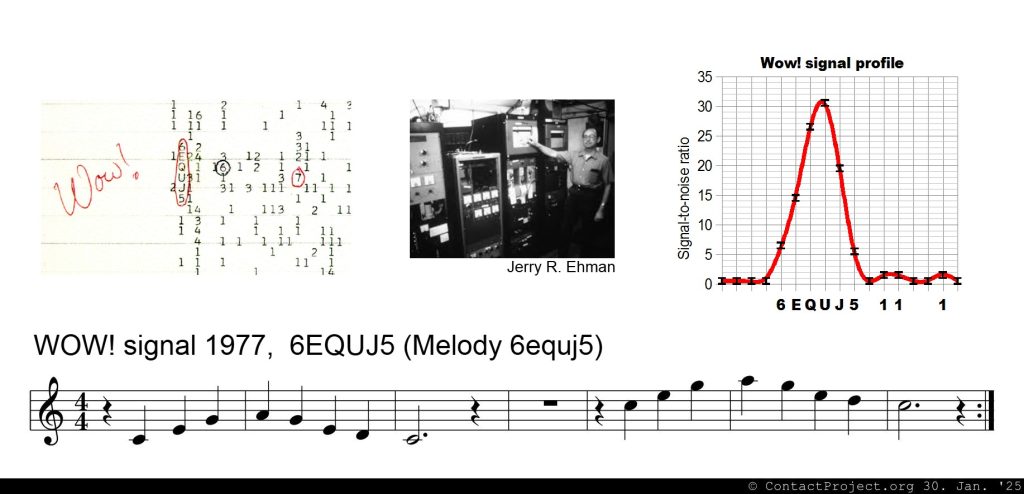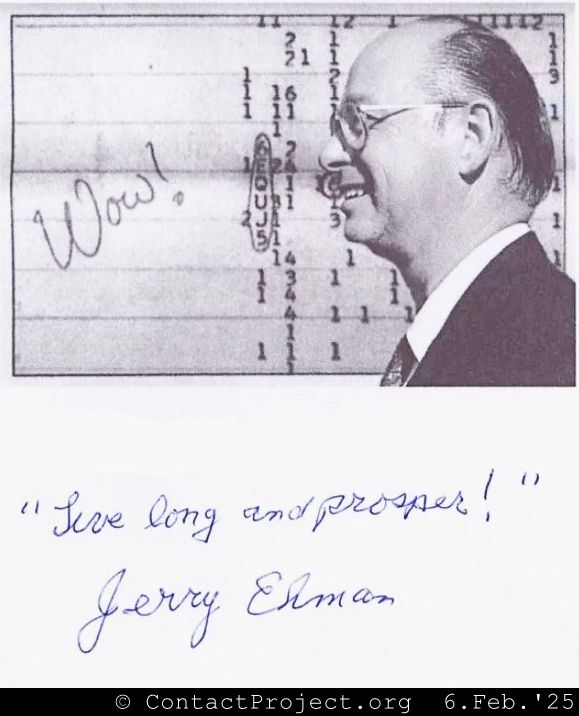| In the Key of the Cosmos: A Signal Sung from the Stars “The Wow! signal melody” is available on Spotify, Apple Music, iTunes, and many others… |
Consider, if you will, a sequence of symbols—6EQUJ5—etched into the annals of astronomy, a cryptic whisper from the depths of space. Once, it was a burst of radio waves, the Wow! signal, a fleeting enigma that haunted our telescopes. Now, in February 2025, it has become a melody. A human act of alchemy, transmuting mathematics into music, static into song.

Here, in this humble arrangement, the numbers and letters unfurl as notes: a progression both melancholic and yearning. The sixth scale degree hums with cosmic longing; the flattened seventh bends like spacetime itself. A raised fourth pierces the silence, a dissonant cry from the void, while the fifth—an anchor—grounds us in the familiar. Together, they form a lullaby for the universe, a sequence as old as hydrogen yet as new as dawn.
Is this what it sounds like when the cosmos composes? Or is it merely our own reflection, a mirror held up to the dark? We cannot know. Yet in these six notes, stretched across octaves and human imagination, we hear the ache of isolation—and the fragile hope of connection.
Perhaps, as in Close Encounters, we have always spoken to the unknown in the language of music. A minor seventh resolves; a chord trembles. The same mathematics that binds atoms may yet bind civilizations.
For now, the melody lingers: a question mark set to rhythm, a cipher unsolved. A reminder that in the grand fugue of the universe, even static may hold symphonies. We need only listen—and dare to reply.


I found myself pondering how the letters and numbers from the Wow! signal notation 6EQUJ5 might translate into a melody. Initially, the idea of creating a song from these characters seemed quite improbable. You can now listen to the track by clicking on the cover art. It’s my first single! We haven’t expanded these six notes yet.
Erich Habich-Traut
Based on the standard diatonic scale and common chord progressions, here’s a breakdown of the likely tonal values:
Individual notes:
* 6: This is typically the sixth scale degree of the major or minor scale, creating a major or minor sixth interval from the root. It often adds a sense of yearning or longing.
* e: This is the third scale degree, creating a major or minor third interval. It’s a consonant and stable note, often used in melodies and harmonies.
* q: This likely refers to the flat seventh scale degree (b7), creating a minor seventh interval. It adds a bluesy or jazzy flavor and can create a sense of resolution when moving to the root.
* u: This might refer to the raised fourth scale degree (#4), creating an augmented fourth interval. It’s a dissonant and unstable note, often used to create tension and drama.
* j: This likely refers to the flat sixth scale degree (b6), creating a diminished fifth interval. It’s also dissonant and can add a bluesy or jazzy feel.
* 5: This is the fifth scale degree, creating a perfect fifth interval. It’s a consonant and stable note, often used in melodies and harmonies.

Here’s a possible melody in C major, using the provided notes (6, e, q, u, j, 5) with a melancholic feel and simple piano rhythm.
Melody:
C (5) – E (e) – G (5) – A (6) – G (5) – E (e) – D (q) – C (5)
C (5) – E (e) – G (5) – A (6) – G (5) – E (e) – D (q) – C (5)
Rhythm:
Each note is played with a quarter note duration (a steady beat).
Piano Playing Style:
Play with a gentle touch and sustain the notes slightly for a more expressive sound. Experiment with dynamics (louder and softer notes) to create a sense of ebb and flow.
Key Considerations:
Melancholic Feel: The descending line from A to G and the use of the minor seventh (D) contribute to the melancholic mood.
Simplicity: The repetition of the melodic phrase and the consistent quarter note rhythm create a sense of simplicity and introspection.

WOWsignal #closeencountersofthethirdkind #closeencounter #UFO #ufology #ufologia #alternative
